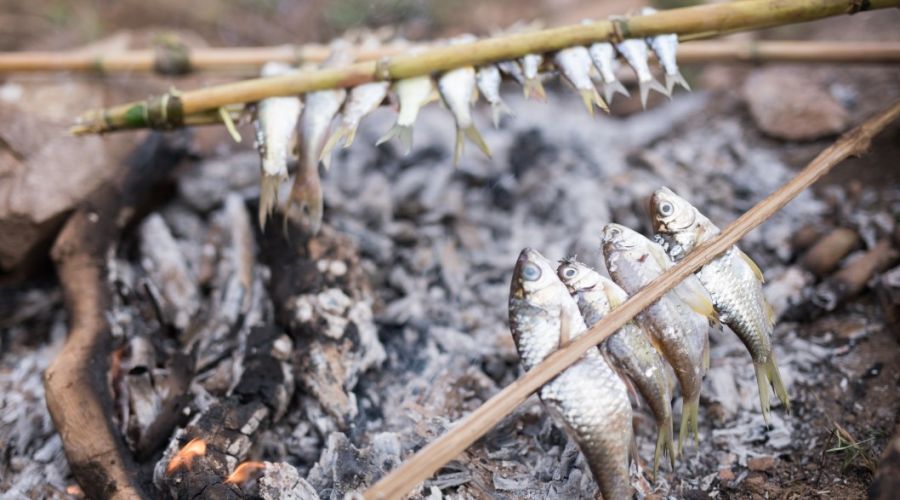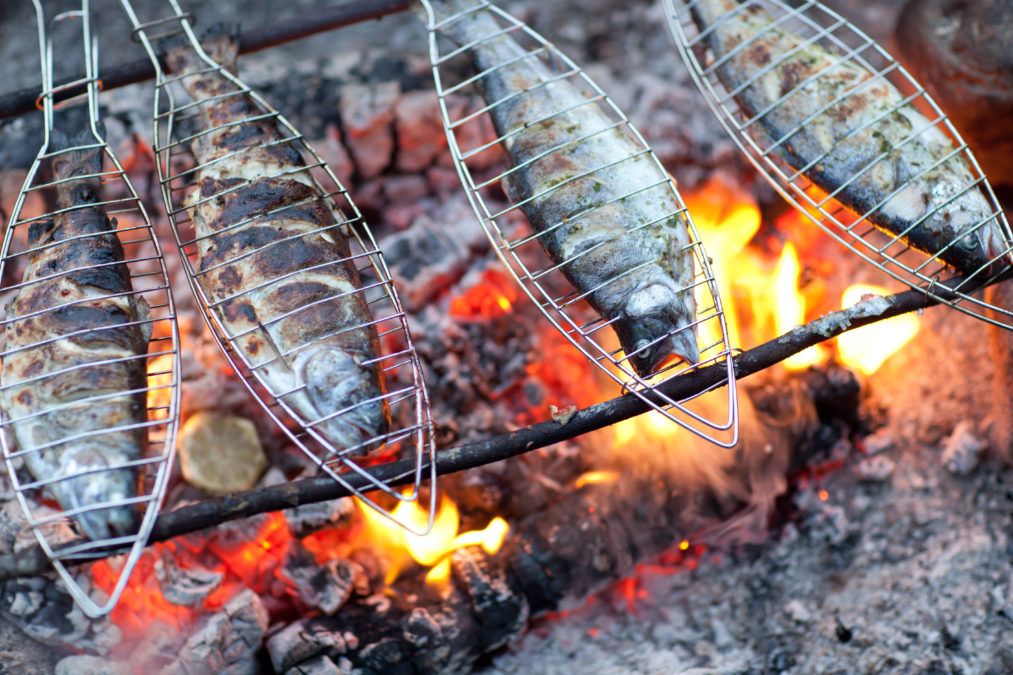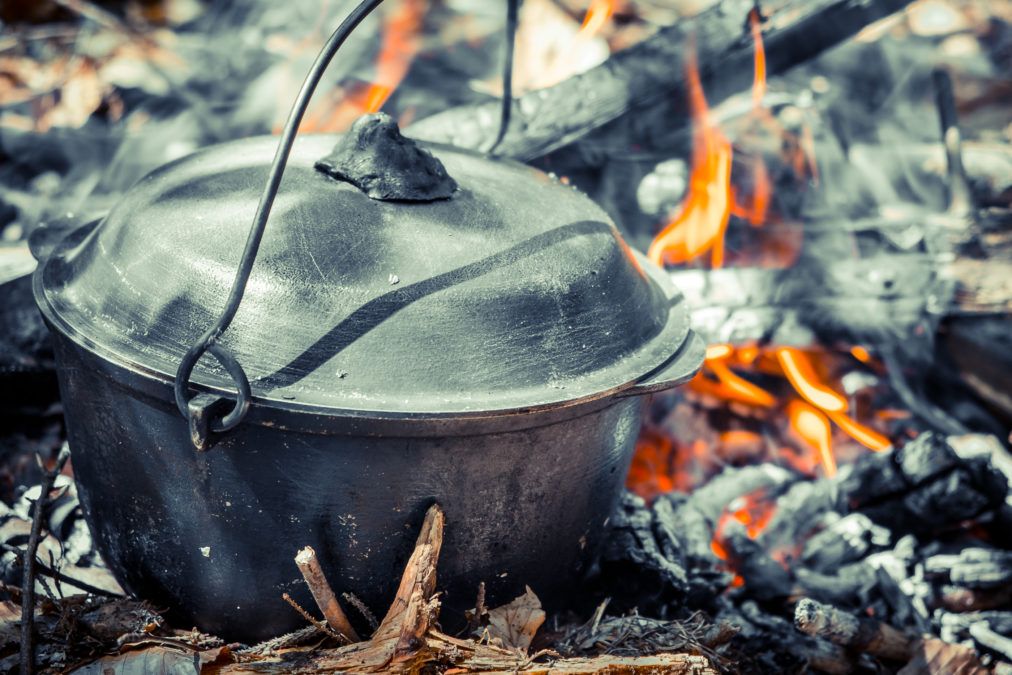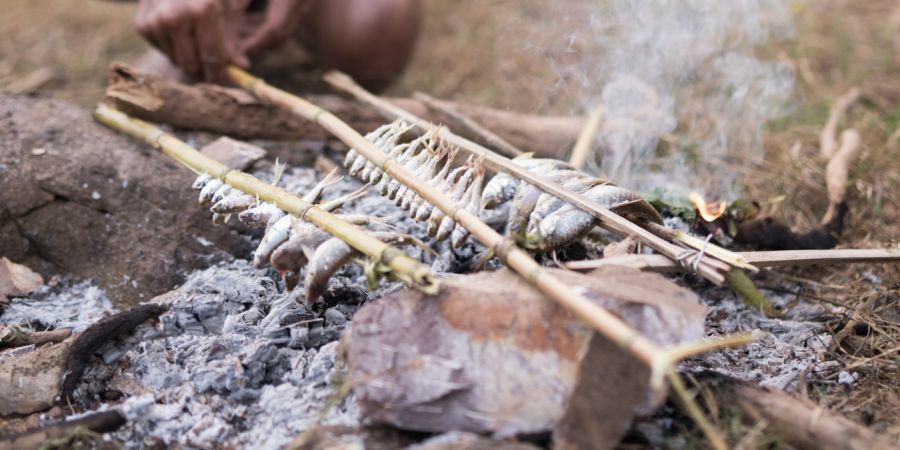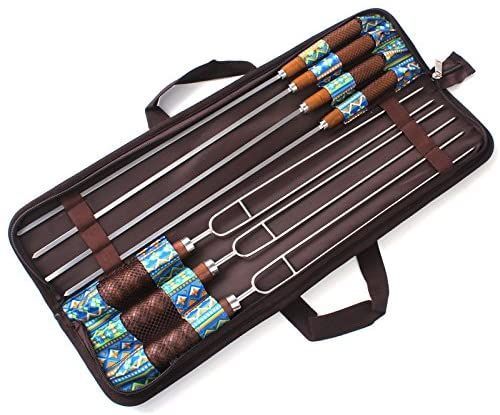Nothing beats being out in the woods for building up an appetite. It can be challenging to cook in the rough. However, you don't need to carry around unnecessary and heavy tools. You can set up a cooking fire with little more than tin foil, tinder, and pieces of wood. It can provide a place to create meals worthy of a four-star restaurant, including dessert. If you like cooking sweets, make sure to check how to make s'mores on the grill.
What kind of fire you build and which tools you bring will depend on what sort of camping you're doing. If you are on an established spot night after night, then chances are you will have access to a fire pit. Always use a fire pit, if you can. It shows respect for nature and is safer. If you are on the move, you will need to build a small pit each night.
There are many tasty dishes that you can cook over a campfire. However, if you really want to feel the true nature around you, the most iconic choice is going to be a fish. Catching fresh fish and cooking it over a campfire will allow you to not only eat a delicious meal but also to have a real camping experience. Keep reading to find the best ways to cook fish over a campfire!
On the Move Campfire Cooking
An on-the-move fire will be small but will be more than enough to cook dinner, boil clean water, and warm your toes! Most backpackers, cycling tourers, and long-distance hikers will want to carry as little gear as possible. For most meals, all you'll require is some tin foil and greenwood.
Building Your Fire
Select a spot away from any overhanging trees and some distance from your tent. It should be at least eight feet away from brush or other significant vegetation. If it’s windy, you should forgo lighting a campfire because even the smallest windborne spark can ignite a forest fire.
Clear the soil down to stone, if possible. If not, scoop away the top organic layers. Surround your area with medium-sized stones. If there is a wind, place a larger stone as a blocker. It will also serve to reflect heat at the cooking.
Circularly build a ‘teepee’. Use only small dry twigs and sticks. Do not use greenwood. Place paper, dry pine needles, and other easy combustibles in the center of the teepee loosely. Set your fire and feed it small tinder until your teepee catches.
Prepping and Cooking Your Food
As your wood burns, creating good charcoal, prepare your veggies and fish. Start by slicing the food into uniform-sized pieces. Slice easily cooked food thicker and slow cooking food thinner. Lay the food on a good-sized bit of tin foil. Season and drip a little hot water into the food. Fold into a sealed packet. Lay on top of hot coals, just outside of the active flame. To cook faster, layer hot coals over the packet. Your food will steam quickly; plenty of fish and veggies will be ready to eat in under twenty minutes.
Stationary Fire-pit Fish Cooking
If you're cooking night after night in the same place, you'll be able to build a much more complicated cooking fire. Most stationary campers bring fire-safe pots, as weight is far less of an issue. You can also bring a small wire grill for grilled goodies over coals.
Build Your Fire Pit
If your campsite does not have a fire pit, select a location away from overhanging branches and brush. Scrape out a roughly rectangular space, removing all organic matter. Place stones around the short sides of your pit. On the front long side, place along with large green split log. You will be placing your cook pots on the green log as the fire burns. The indirect heat will cook and flavor your fish and veggies.
If you want to grill, you'll need to place stable stones or dry wood at one end of the fire to support the grill before you build up the fire. Rake coals under the camp grill; they'll provide wonderful flavoring. Flare-up is minimized by cooking over coals.
Use a Hanging Frame
You can also get crafty and craft a picturesque hanging frame out of three sturdy branches, using two branches of roughly the same length and a Y fork at one end as support. Balance a sturdy green branch across them, high enough to be out of the flames. Hang pots, large cuts of well-marbled fish, or small cleaned veggies. The direct flame will sear in the juices as it cooks up but try to keep the fire six inches below your food. Tend your camping meal often; it can burn easily.
Fish Over a Campfire
Few things taste better than freshly cooked fish by the side of a clear mountain lake or stream shortly after the fish has been caught. Here are some additional tips and tricks that can make the difference between enjoying a well-crafted meal prepared over a campfire and resorting to emergency rations.
Frying in a Cast Iron Skillet
Frying is the most popular way to prepare fish over a campfire. A cast-iron skillet is the best because it’s capable of holding an even, hot heat. Camping supply stores sell cast iron cookware specifically for use with campfires, although if you’ve got a cast-iron frying pan at home, it will do just as nicely.
You’ll need a clean-burning fire to fry your fish on. Using foraged green wood will result in a smoky fire that will impart a terrible taste to your fish. Many campgrounds supply seasoned firewood to guests, so be sure to check before your departure. If the campground that you’re going to doesn’t have firewood for campers, picking some up before your trip is a good idea.
It’s important to get the oil hot before adding the fish, so place the pan over the fire until the oil begins to bubble. A simple cooking grate that you can place over the fire will allow a flat direct heat transfer surface.
Breading Your Fish
Although freshly caught fish can taste fabulous without breading, it augments flavor and adds texture. The best bread is simply a bit of flour, cornmeal, cracked black pepper, and a pinch of salt. Remember, the fish with salt always tastes best. Some cooks like to add ground roasted red pepper or ground garlic, but that’s purely a personal decision. The breading can be made before the camping trip and placed in a plastic bag so that all you have to do is put the cleaned fish fillets in the bag and shake it up.
Depending on the size of the fish and the appetites of those in your party, you’ll need roughly one-half to one whole filet per person. The fish should be placed in the pan after the oil has heated sufficiently and flipped often until the breading is golden brown and the meat inside is flaky.
Cooking Fish On A Stick
First, you will need to get your roasting stick and some forked sticks that you will use as support. The roasting stick should be strong because it will have to support the weight of the fish. Willows, which are often found near water, make great roasting sticks. You will need to insert the roasting stick through the mouth of the fish. If you have smaller fish, you can also jam them between two sticks tied together at both ends.
BBQ Tool Set
Seven-piece set of BBQ tools, including three stainless steel needles, three barbecue forks, and a case.
You can begin cooking the fish as soon as the flames have died down a little bit. To test the temperature, hold your hands over the coals. If the coals are so hot that you can only hold your hand over them for a few seconds, then you have the right temperature for cooking.
Place the fish over the coals with the scales pointed towards the heat. Cook the fish for five to ten minutes, or until you notice that the skin is becoming crispy and charred. After that, turn the fish over so that the open side is now facing the heat.
Once the fish is cooked thoroughly, peel off the skin. Then remove the stick and lay the fish on a clean rock. Use a fire extinguisher to put out the fire. If you have leftover fish, bury it or put it back in the water.
The Conclusion
There are many ways to cook fish over a campfire. The truth is there isn't something like the best method of cooking fish. All of them have various pros and make your fish taste great. Depending on how you want to cook it, a different way can be best for this particular reason. My suggestion is to try them all to find the one that suits your cooking needs the most, and that will make your fish taste the best.
Let us know your favorite fish cooking method over a campfire way in the comment section below. And as always, please share!

